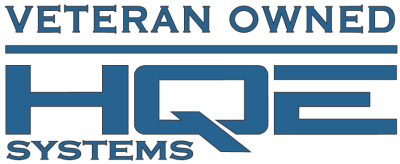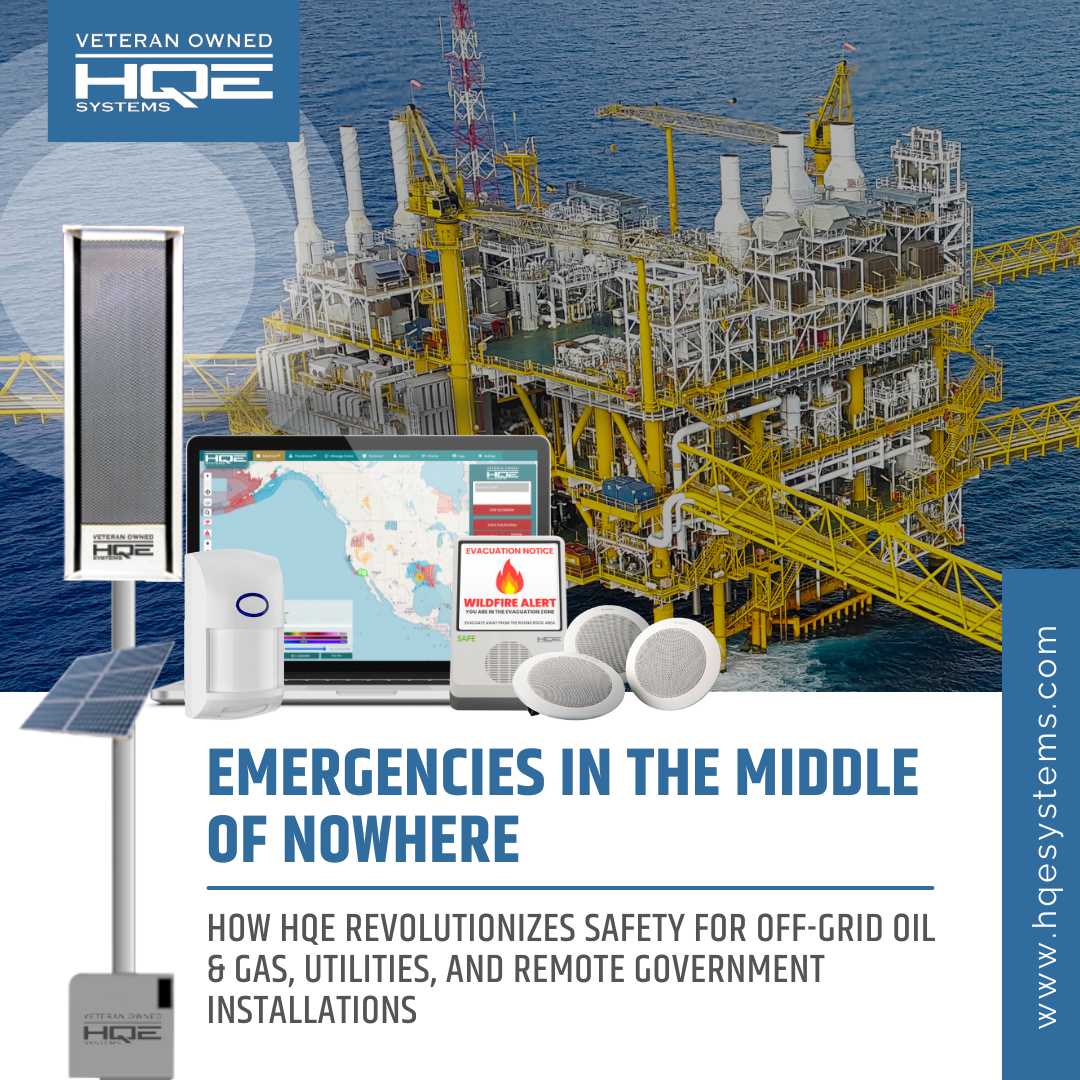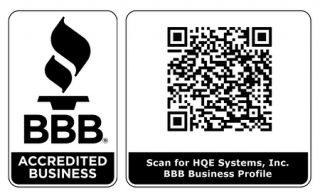Emergencies in the Middle of Nowhere: How HQE Systems is Revolutionizing Safety for Off-Grid Oil & Gas, Utilities, and Remote Government Installations
A Desperate Emergency in the Middle of Nowhere
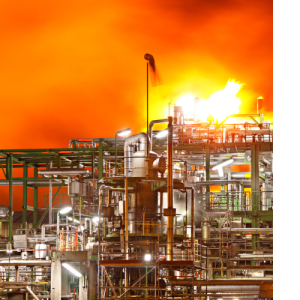 It was a calm afternoon at an oil rig in the Gulf of Alaska when disaster struck. A sudden storm rolled in, bringing violent winds and sub-zero temperatures. The rig’s power systems faltered, communication lines went down, and the workers found themselves stranded miles from the nearest support. As the power failed, safety mechanisms malfunctioned, and critical infrastructure started to freeze. With no way to communicate with mainland responders, the situation turned dire. Hours passed, and with no access to external help, the rig became a ticking time bomb. What started as a typical storm became a life-threatening emergency.
It was a calm afternoon at an oil rig in the Gulf of Alaska when disaster struck. A sudden storm rolled in, bringing violent winds and sub-zero temperatures. The rig’s power systems faltered, communication lines went down, and the workers found themselves stranded miles from the nearest support. As the power failed, safety mechanisms malfunctioned, and critical infrastructure started to freeze. With no way to communicate with mainland responders, the situation turned dire. Hours passed, and with no access to external help, the rig became a ticking time bomb. What started as a typical storm became a life-threatening emergency.
Scenarios like this one are more common than we think, especially for isolated facilities like oil rigs, utility grids, and remote government installations. These facilities are vulnerable to environmental extremes, communication breakdowns, and prolonged power outages, making even routine operations perilous in emergencies.
Real-World Example: Texas Winter Storm (2021)
In February 2021, Winter Storm Uri wreaked havoc across Texas, plunging millions into darkness as the state’s power grid collapsed under freezing conditions (The Texas Tribune) (Texas Oil & Gas Association). Over 4.5 million homes and businesses were left without power for days, causing widespread disruption. The oil and gas industry, particularly in the Permian Basin, suffered enormous setbacks. The freezing temperatures caused natural gas production to plummet as pipelines froze, and vital equipment at remote drilling sites failed.
Remote oil and gas installations were among the hardest hit. With limited access to grid power and harsh weather preventing easy access to backup systems, many remote fields had to halt production. Equipment froze, and crucial operations stalled, resulting in millions of dollars in losses. It became clear that remote installations, dependent on minimal power systems, were particularly vulnerable during prolonged outages.
Real-World Example: Colonial Pipeline Cyberattack (2021)
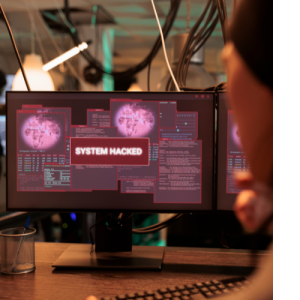 In May 2021, a ransomware attack crippled the Colonial Pipeline, which transports fuel to much of the U.S. East Coast. The attack forced the company to shut down the pipeline for several days, causing widespread fuel shortages and highlighting the growing threat of cyberattacks on critical infrastructure (NCSL). While the Colonial Pipeline wasn’t located in an extremely remote area, the incident underscored how vulnerable essential infrastructure can be to digital threats.
In May 2021, a ransomware attack crippled the Colonial Pipeline, which transports fuel to much of the U.S. East Coast. The attack forced the company to shut down the pipeline for several days, causing widespread fuel shortages and highlighting the growing threat of cyberattacks on critical infrastructure (NCSL). While the Colonial Pipeline wasn’t located in an extremely remote area, the incident underscored how vulnerable essential infrastructure can be to digital threats.
For isolated oil and gas facilities, which rely on digital systems for monitoring and control, a similar attack could have even more severe consequences. Without immediate access to cybersecurity teams, these installations may be forced to shut down for extended periods. In more remote areas, the impact of a cyberattack is amplified by the difficulties in securing equipment and restoring operations in isolated locations.
Real-World Example: Alaska’s Remote Microgrids
In Alaska, many communities and industrial sites rely on microgrids to meet their energy needs. These microgrids—isolated from traditional power lines—are vital for areas that experience long, harsh winters and extreme weather conditions (OILMAN Magazine). However, when these systems fail, the consequences can be dire. In some cases, remote communities have been left without power for days during severe winter storms, leading to life-threatening situations as temperatures plummet.
Microgrids in remote Alaskan communities face unique challenges. Heavy snowfall, ice storms, and extended periods of darkness strain energy systems, and if equipment fails, these sites are often left with few options for immediate repair. Many of these locations are only accessible by air or snowmobile during winter months, making quick repairs nearly impossible.
Real-World Example: Deepwater Horizon Oil Spill (2010)
 Though over a decade old, the Deepwater Horizon disaster serves as a crucial reminder of how catastrophic emergencies at remote installations can be (NCSL). Located 40 miles off the coast of Louisiana, the oil rig suffered a blowout that resulted in the largest marine oil spill in history. Without immediate access to emergency response teams, the situation quickly spiraled out of control, causing lasting environmental and economic damage.
Though over a decade old, the Deepwater Horizon disaster serves as a crucial reminder of how catastrophic emergencies at remote installations can be (NCSL). Located 40 miles off the coast of Louisiana, the oil rig suffered a blowout that resulted in the largest marine oil spill in history. Without immediate access to emergency response teams, the situation quickly spiraled out of control, causing lasting environmental and economic damage.
The blowout revealed the difficulties in managing emergencies at offshore installations, where extreme isolation means that help is hours—if not days—away. Communication systems failed, and remote monitoring equipment couldn’t prevent the disaster from escalating. The need for enhanced monitoring and emergency response capabilities at such remote installations has never been clearer.
Unique Risks of Remote Installations
Remote facilities, such as oil and gas fields, utility grids, and government installations, face unique vulnerabilities that increase the likelihood of emergencies:
1. Power Instability
 Many remote installations rely on isolated power sources such as generators or microgrids. When these systems fail—whether due to extreme weather or mechanical breakdown—the consequences can be catastrophic. Prolonged power outages can lead to equipment failure, safety risks, and even environmental disasters. For example, in extreme cold, oil pipelines can freeze and rupture without power to maintain temperature controls.
Many remote installations rely on isolated power sources such as generators or microgrids. When these systems fail—whether due to extreme weather or mechanical breakdown—the consequences can be catastrophic. Prolonged power outages can lead to equipment failure, safety risks, and even environmental disasters. For example, in extreme cold, oil pipelines can freeze and rupture without power to maintain temperature controls.
2. Communication Failures
In many isolated locations, communication networks are weak or nonexistent. In the event of an emergency, this leaves facilities without the ability to call for help, alert workers, or shut down operations. Communication breakdowns during a disaster can turn a manageable situation into a life-threatening crisis.
3. Environmental Extremes
From the frozen tundras of Alaska to the blistering heat of deserts in the Middle East, remote sites are often located in extreme environments that place additional strain on infrastructure. The risk of equipment failure increases dramatically under harsh environmental conditions, especially during prolonged exposure to extreme weather.
4. Human Threats
Remote installations are also prime targets for sabotage, cyberattacks, and vandalism. Isolated facilities often lack sufficient security measures, and the time it takes for help to arrive can make these locations highly vulnerable to malicious attacks. This has been underscored by the rise in cyberattacks on critical infrastructure, such as the Colonial Pipeline incident.
HQE Systems: A Game-Changer for Remote Installations
In the face of the unique risks and challenges that remote installations face—whether it’s severe weather, power instability, communication breakdowns, or cyberattacks—HQE Systems provides comprehensive solutions that ensure resilience, reliability, and safety. Among these is HQE’s revolutionary SAFE Network™. This innovative system is designed to maintain communication, send alerts, and keep people informed even when traditional power grids and cellular networks fail. Here’s a more detailed look at how HQE’s SAFE Network and other solutions tackle critical issues.
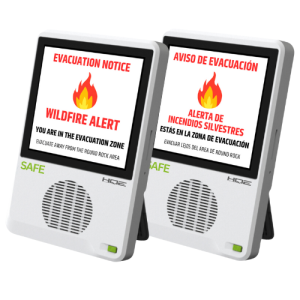 Introducing the SAFE Network™
Introducing the SAFE Network™
The SAFE Network™ (Stand-Alone Field Emergency Network) is a critical incident communication system designed specifically for scenarios when other systems—like cellular networks and power grids—are down. Unlike conventional alert systems that depend on infrastructure, the SAFE Network™ operates independently, ensuring that even in the most severe emergencies, critical alerts can still be received and shared.
How SAFE Network™ Works
The SAFE Network PAU™ (Portable Alert Unit) is the core of this system. It operates with its own power supply, ensuring that it remains active for up to 10 days without external electricity. Here’s a deeper dive into the features that make the SAFE Network™ so powerful:
- Independent Power Source: One of the key features of the SAFE Network™ is its ability to function without relying on external power grids. With up to 10 days of standby power, this system can keep functioning long after conventional power has gone out. Whether it’s during a hurricane, wildfire, or earthquake, the SAFE Network™ ensures continuous communication.
- Grid-Free Communication: During emergencies, when cellular networks are often overloaded or knocked offline, the SAFE Network™ bypasses traditional infrastructure. It can send audiovisual alerts through its built-in speakers and flashing lights, ensuring that vital information is shared even if mobile networks and Wi-Fi are down. This makes it ideal for areas that lose communication due to natural disasters, like hurricanes or earthquakes.
- Audiovisual Alerts: SAFE Network™ provides attention-grabbing audio and visual alerts that cut through panic and confusion. The moment a message is received, the unit delivers a clear, noticeable tone and displays a visible message on its screen. This feature is critical during power outages when people may not be able to rely on their phones or internet to get updates.
 Text Alerts: Another unique feature is its ability to send and receive text messages during emergencies, ensuring that people can communicate with loved ones, emergency services, or teams even during a blackout. For instance, a family could send an update such as “We are safe, stay indoors” even when cellular service has been disrupted.
Text Alerts: Another unique feature is its ability to send and receive text messages during emergencies, ensuring that people can communicate with loved ones, emergency services, or teams even during a blackout. For instance, a family could send an update such as “We are safe, stay indoors” even when cellular service has been disrupted.- Portable and On-the-Go: The PAU™ is designed to be portable, which means it can be taken anywhere, whether it’s being moved during an evacuation or used to keep remote workers in contact with emergency response teams. This portable capability is a major advantage in disaster scenarios, such as wildfires or hurricanes, where people may need to evacuate quickly but still remain connected to essential alerts.
Widespread Applications for SAFE Network™
The versatility of the SAFE Network™ makes it applicable across a range of scenarios and user groups:
- Families: During emergencies, the SAFE Network™ keeps families informed and connected. Whether at home or evacuating during a disaster, this system ensures that families can stay updated with life-saving alerts even when other networks fail.
- Businesses and Critical Infrastructure: For businesses, especially those managing critical infrastructure like power plants, the SAFE Network™ offers an essential layer of protection by ensuring that emergency alerts can still be sent and received when other communication lines are down.
- Remote Workers: In isolated locations, whether it’s in the middle of a forest, an offshore oil rig, or a mountain research facility, staying connected can be life-saving. The SAFE Network™ ensures that remote workers in these areas remain linked to vital updates during emergencies, ensuring their safety and well-being.
Complementary HQE Solutions
In addition to the SAFE Network™, HQE Systems offers a range of other solutions tailored to the unique needs of remote installations:
1. Resilient Off-Grid Power Solutions
 HQE’s off-grid power systems are designed to operate in even the most isolated and inhospitable locations. These systems integrate renewable energy sources like solar panels and wind turbines with advanced battery storage and backup generators to ensure a continuous power supply, even during prolonged grid outages.
HQE’s off-grid power systems are designed to operate in even the most isolated and inhospitable locations. These systems integrate renewable energy sources like solar panels and wind turbines with advanced battery storage and backup generators to ensure a continuous power supply, even during prolonged grid outages.
- Solar-Powered Microgrids: In areas with significant sunlight exposure, such as desert-based facilities, solar panels collect energy during the day, storing it in batteries for nighttime use. This setup ensures uninterrupted power without relying on external grids, which is crucial in areas that may be cut off during emergencies.
- Wind Turbines and Hybrid Systems: For regions with consistent wind, HQE integrates wind power to complement solar energy. This approach works particularly well in offshore locations or mountainous areas. By combining multiple renewable sources, HQE ensures that even if one power source falters, another can step in, reducing the risk of outages.
2. Real-Time Monitoring and Automation
HQE’s real-time monitoring systems provide a constant stream of data on the performance of equipment, environmental conditions, and energy systems. This level of monitoring allows for early detection of potential failures, enabling operators to take proactive measures before a situation escalates into an emergency.
- Environmental Sensors: For installations located in extreme environments, HQE’s monitoring systems can track factors such as temperature, wind speed, and humidity, which could impact operations. For example, in fire-prone areas, monitoring the air for smoke particles can provide early warning of nearby wildfires, allowing for timely evacuations or operational shutdowns.
- Automated Shutdowns: In the event that a critical failure is detected—such as a pipeline leak or an electrical fault—HQE’s systems can automatically shut down operations to prevent damage, injuries, or environmental contamination. This automation is essential for remote sites where human intervention may not be immediately available.
3. Secure Communication Networks
 Communication during emergencies is key, and HQE’s solutions ensure that remote facilities stay connected even when traditional communication networks fail. The SAFE Network™ is just one example of how HQE provides redundant communication options to ensure that messages get through in an emergency.
Communication during emergencies is key, and HQE’s solutions ensure that remote facilities stay connected even when traditional communication networks fail. The SAFE Network™ is just one example of how HQE provides redundant communication options to ensure that messages get through in an emergency.
- Satellite Communication: In areas without reliable cellular networks, HQE’s systems utilize satellite communication to maintain connectivity. This ensures that even if local infrastructure is damaged or offline, remote teams can still communicate with central command or emergency services.
- Radio and Encrypted Communication: For sites that need to maintain high levels of security, such as government facilities or sensitive industrial locations, HQE’s systems offer encrypted communication networks that protect data from interception or cyberattacks.
4. Cybersecurity Solutions
As cyber threats become increasingly sophisticated, remote installations are more vulnerable than ever to attacks that could disrupt operations. HQE’s cybersecurity solutions include advanced firewalls, intrusion detection systems, and automated threat responses to ensure that digital infrastructure remains secure, even in isolated locations.
- Automated Response: If a breach is detected, HQE’s systems can isolate affected networks and initiate automated responses, such as cutting off access to critical systems or initiating a full system lockdown. This helps prevent widespread damage in the event of a cyberattack, buying time for human intervention.
Conclusion: Revolutionizing Safety for Remote Installations
The future of emergency management for remote installations lies in resilience, adaptability, and innovation. HQE Systems is transforming how oil and gas fields, utility grids, and government installations prepare for and respond to crises. Whether it’s maintaining power during a hurricane, ensuring communication after an earthquake, or preventing cyberattacks, HQE’s solutions provide a comprehensive safety net for the most vulnerable and isolated facilities.
management for remote installations lies in resilience, adaptability, and innovation. HQE Systems is transforming how oil and gas fields, utility grids, and government installations prepare for and respond to crises. Whether it’s maintaining power during a hurricane, ensuring communication after an earthquake, or preventing cyberattacks, HQE’s solutions provide a comprehensive safety net for the most vulnerable and isolated facilities.
With systems like the SAFE Network™, HQE ensures that critical alerts, power, and communication remain active when everything else fails—ensuring the safety of people, infrastructure, and the environment, no matter the circumstances.
HQE Systems is a certified Veteran Owned Company. For more information about HQE Systems Inc. and its emergency management, electronic security, and integration solutions, please visit www.hqesystems.com.

Contact: David Ditto (Early Warning Systems Subject Matter Expert)
Email: David.Ditto@hqesystems.com
Phone Number: (843) 872-7020
____________________
HQE Systems, Inc. | HQE is a Minority-Owned Service Disabled Veteran Owned Small Business (SDVOSB) providing full solutions for: Mass Notification Systems, Electronic Security Systems, Software Development Services, Contract Support, and Prototyping Services. As a brand-agnostic solutions provider, HQE prides itself in providing the BEST solution for the project. HQE possesses over 30+ factory certifications and reseller licenses to ensure our clients receive the highest quality service at the ideal budget. HQE can provide full design, installation, integrations, upgrades, and long-term maintenance support for any size and scope project.
